
Hibbertia scandens, sometimes known by the common names snake vine, climbing guinea flower and golden guinea vine, is a species of flowering plant in the family Dilleniaceae and is endemic to eastern Australia. It is climber or scrambler with lance-shaped or egg-shaped leaves with the narrower end towards the base, and yellow flowers with more than thirty stamens arranged around between three and seven glabrous carpels.

Hibbertia sericea, commonly known as silky guinea-flower, is a species of flowering plant in the family Dilleniaceae and is endemic to south-eastern Australia. It is an erect or spreading shrub with softly-hairy branches, elliptic to egg-shaped leaves with the narrower end towards the base, and yellow flowers with eight to fourteen stamens in a cluster on one side of two hairy carpels.

Hibbertia aspera, commonly known as rough guinea flower, is a species of flowering plant in the family Dilleniaceae and is endemic to eastern Australia. It is an ascending or erect shrub with low-lying or scrambling branches, oblong to lance-shaped or egg-shaped leaves with the narrower end towards the base, and yellow flowers with four to six stamens in a single group, joined at the base.

Hibbertia empetrifolia, commonly known as trailing guinea-flower, is a species of flowering plant in the family Dilleniaceae and is endemic to south-eastern Australia. It is a low-lying to spreading shrub with wiry stems, oblong to lance-shaped leaves with the narrower end towards the base, and pale to bright yellow flowers arranged on the ends of branchlets, with five to nine stamens arranged on one side of the two carpels.

Hibbertia riparia, commonly known as erect guinea-flower, is a species of flowering plant in the family Dilleniaceae and is endemic to the south-eastern Australia. It is an erect to spreading shrub with hairy foliage, linear leaves and yellow flowers with six to sixteen stamens in a single cluster on one side of two carpels.

Hibbertia stricta is a species of flowering plant in the family Dilleniaceae and is endemic to New South Wales. It is a small, usually upright shrub with hairy foliage, linear leaves and yellow flowers with six or seven stamens arranged around two woolly-hairy carpels.

Hibbertia hermanniifolia is a species of flowering plant in the family Dilleniaceae and is endemic to eastern Australia. It is an erect shrub with spatula-shaped to wedge-shaped leaves and yellow flowers arranged singly in leaf axils, with ten to fifteen stamens arranged around two hairy carpels.
Hibbertia serpyllifolia is a species of flowering plant in the family Dilleniaceae and is endemic to Queensland. It is a small, spreading to low-lying shrub with many stems, oblong leaves and single yellow flowers on the ends of branches, with twelve to twenty stamens in groups around three hairy carpels.
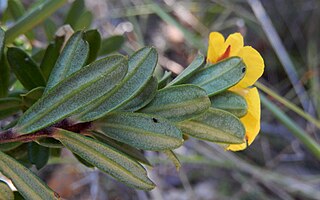
Hibbertia bracteata is a species of flowering plant, in the family Dilleniaceae, and is endemic to eastern New South Wales. It is a shrub with lance-shaped to oblong leaves and yellow flowers with about sixteen stamens arranged on one side of the two carpels.

Hibbertia calycina, commonly known as the lesser guinea flower, is a species of flowering plant in the family Dilleniaceae and is endemic to south-eastern Australia. It is a small shrub with linear leaves and yellow flowers with eight to eighteen stamens in a single cluster on one side of the two carpels.
Hibbertia cinerea is a species of flowering plant in the family Dilleniaceae and is endemic to the southern part of the Eyre Peninsula in South Australia. It is a densely-branched, hairy shrub with narrow elliptic to lance-shaped leaves, and yellow flowers arranged on the ends of branchlet, with nine to twelve stamens arranged in a group on one side of the two carpels.
Hibbertia cockertoniana is a species of flowering plant in the family Dilleniaceae and is endemic to the south-west of Western Australia. It is an erect shrub with scattered linear leaves and yellow flowers arranged singly in leaf axils usually with ten stamens all on one side of the two carpels.
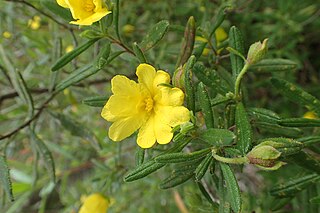
Hibbertia furfuracea is a species of flowering plant in the family Dilleniaceae and is endemic to near-coastal areas of south-western Western Australia. It is an erect shrub with narrow egg-shaped leaves with the narrower end towards the base, and yellow flowers borne in upper leaf axils, with ten to twelve stamens all on one side of two carpels.
Hibbertia intermedia is a species of flowering plant in the family Dilleniaceae and is endemic to New South Wales. It is a small shrublet with linear to narrow oblong leaves and yellow flowers usually with seven to nine stamens arranged in a single cluster.
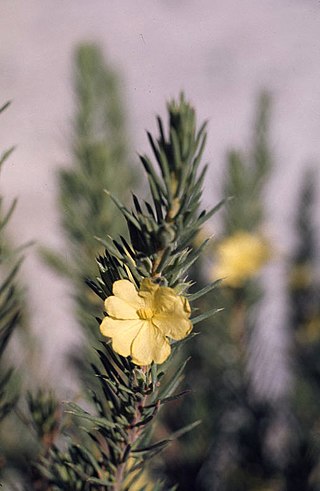
Hibbertia mucronata is a species of flowering plant in the family Dilleniaceae and is endemic to the south of Western Australia. It is an erect shrub with hairy branches, crowded, thick, tapering linear leaves ending in a sharp point, and golden yellow flowers with five stamens fused at their bases, all on one side of two densely hairy carpels.
Hibbertia nitida is a species of flowering plant in the family Dilleniaceae and is endemic to the Central Coast of New South Wales. It is an erect shrub with lance-shaped leaves with the narrower end towards the base and yellow flowers with about eleven stamens arranged on one side of two silky-hairy carpels.
Hibbertia oblongata is a species of flowering plant in the family Dilleniaceae and is endemic to northern Australia. It is an erect to spreading shrub with scaly foliage, elliptic to oblong leaves, and yellow flowers usually arranged singly in leaf axils, with 16 to 36 stamens arranged in bundles around the two carpels.
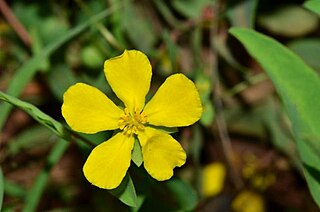
Hibbertia silvestris is a species of flowering plant in the family Dilleniaceae and is endemic to the south-west of Western Australia. It is a prostrate to more or less erect or spreading shrub with hairy young branchlets, elliptic to egg-shaped leaves with the narrower end towards the base and yellow flowers with seven to ten stamens on one side of two softly-hairy carpels.
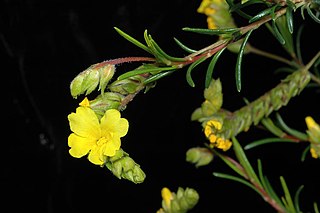
Hibbertia spicata is a species of flowering plant in the family Dilleniaceae and is endemic to the west of Western Australia. It is a low, erect to spreading shrub with scattered linear leaves with the edges rolled under and yellow flowers with six or seven stamens on one side of two softly-hairy carpels, and a larger number of staminodes.
Hibbertia verrucosa is a species of flowering plant in the family Dilleniaceae and is endemic to the south-west of Western Australia. It is a shrub with scattered, densely hairy, narrowly rectangular leaves and yellow flowers usually with ten stamens fused at the bases, all on one side of two densely softly-hairy carpels.














